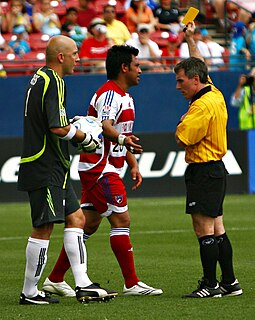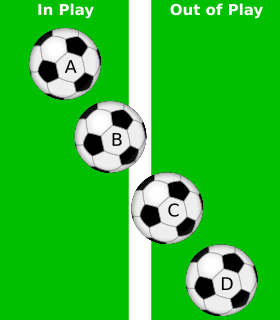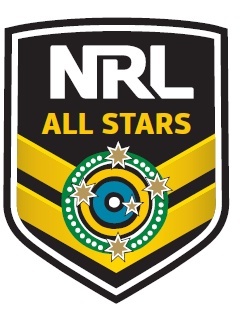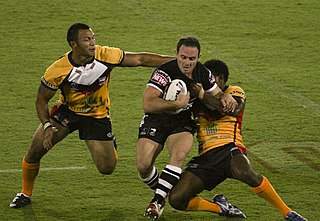Rugby union
Rugby union touch judges support the referee by marking 'touch' (identifying when the ball leaves the playing area and comes into contact with something there or when the player carrying the ball steps out of the playing area), indicating successful kicks at goal and marking offside lines at set piece plays (the scrum and line out).
Depending on the relevant national regulations, touch judges can be recognised as 'assistant referees' and can have the authority to indicate foul play, support with pre-match protocols and other roles delegated to them by the referee.
In England, touch judges are only recognised as assistant referees when appointed by the RFU or by the relevant Referees' Society. Touch judges in the vast majority of community matches do not act as assistant referees and cannot comment on matters of foul play or other technical matters.
In test matches, it is normal for the referee and assistant referees to be connected by a radio link to aid the communication of all this information.
At elite levels of the 'sevens' variation of rugby union, additional in-goal assistant referees exist to support the referee with in-goal decisions.

Offside is one of the laws of association football, codified in Law 11 of the Laws of the Game. The law states that a player is in an offside position if any of their body parts, except the hands and arms, are in the opponents' half of the pitch, and closer to the opponents' goal line than both the ball and the second-last opponent.

A referee or simply ref is the person of authority in a variety of sports who is responsible for presiding over the game from a neutral point of view and making on-the-fly decisions that enforce the rules of the sport, including sportsmanship decisions such as ejection. The official tasked with this job may be known, in addition to referee, by a variety of other titles as well, including umpire, judge, arbiter, arbitrator, linesman, commissaire, timekeeper, touch judge or Technical Official.

A try is a way of scoring points in rugby union and rugby league football. A try is scored by grounding the ball in the opposition's in-goal area. Rugby union and league differ slightly in defining 'grounding the ball' and the 'in-goal' area.
The Laws of the Game (LOTG) are the codified rules that help define association football. They are the only rules of association football subscribed to by FIFA. The laws mention the number of players a team should have, the game length, the size of the field and ball, the type and nature of fouls that referees may penalise, the frequently misinterpreted offside law, and many other laws that define the sport. During a match, it is the task of the referee to interpret and enforce the Laws of the Game.

Like most forms of modern football, rugby league football is played outdoors on a rectangular grass field with goals at each end that are to be attacked and defended by two opposing teams. The rules of rugby league have changed significantly over the decades since rugby football split into the league and union codes. This article details the modern form of the game and how it is generally played today, however rules do vary slightly between specific competitions.

The ball in and out of play is the ninth law of the Laws of the Game of association football, and describes to the two basic states of play in the game.

A comparison of American football and rugby union is possible because of the games' shared origins, despite their dissimilarities.

A drop goal, field goal, dropped goal, or pot is a method of scoring points in rugby union and rugby league and also, rarely, in American football and Canadian football.
A drop goal is scored by drop kicking the ball over the crossbar and between the goalposts. After the kick, the ball must not touch the ground before it goes over and through, although it may touch the crossbar.
If the drop goal attempt is successful, play stops and the non-scoring team restarts play with a kick from halfway. If the kick is unsuccessful, the offside rules for a kick apply and play continues until a normal stoppage occurs. Because of the scoring attempt this is usually from the kicked ball going dead or into touch. Defenders may tackle the kicker while he is in possession of the ball, or attempt to charge down or block the kick.
The experimental law variations (ELVs) were a proposed set of amendments to the laws of rugby union. They were proposed by the sport's governing body, the International Rugby Board (IRB), and trialled games at Stellenbosch University in 2006. In 2008 thirteen of the 23 variations trialled were played globally including; greater responsibility for assistant referees, corner posts no longer considered to touch in-goal, no gain in ground if the ball is moved into the 22 by a player from the same team as the kicker, quick throw ins can travel backwards, no restrictions to players in the lineout, restrictions on where receivers and opposition hookers can stand in a lineout, pregripping and lifting allowed, mauls can be pulled down and players can enter with their head and shoulders lower than their hips, offside line is five metres away from the scrum for the backs and scrum half must be positioned close to the scrum, all offences apart from foul play and offsides are a free kick, and unplayable rucks and mauls are restarted with a free kick. In 2009 the IRB approved ten of the laws, rejecting the laws relating to mauls, numbers in a lineout and the increase in sanctions punishable by free kicks.
Rugby union is a team sport played between two teams of fifteen players. It is known for its rich terminology.
This list of rugby league terms is a general glossary of the terminology used in the sport of rugby league football. The sport has accrued a considerable amount of jargon to describe aspects of the game. Many terms originate from the Laws of the Game. A number of aspects of the game have more than one term that refers to them. Different terms have become popularly used to describe an aspect of the game in different places with notable differences between the northern and southern hemispheres.
A penalty in rugby union is the main disciplinary sanction available to the referee to penalise a team who commit deliberate infringements. The team who did not commit the infringement are given possession of the ball and they may either kick it towards touch, attempt a place kick at goal, or tap the ball with their foot and run. It is also sometimes used as shorthand for penalty goal.

The rugby league playing field, also referred to as a pitch or paddock, is the playing surface for the sport of rugby league football and is surfaced exclusively with grass.

Rugby league match officials are responsible for fairly enforcing the Laws of the Game from a neutral point of view during a match of rugby league football and imposing penalties for deliberate breaches of these Laws. The most senior match official is the referee. They may be assisted by a range of other officials depending on the level and rules of the competition.
In rugby league football, the Laws of the Game are the rules governing how the sport is played. The Laws are the responsibility of the Rugby League International Federation, and cover the play, officiating, equipment and procedures of the game.

The Rugby League All Stars Match of the National Rugby League is an annual rugby league football match between the specially-formed Indigenous All Stars and an All Stars team, both of whose members are made available for selection public vote. The game has been played since 2010 at Gold Coast, Queensland's Skilled Park. The player judged man-of-the-match is awarded the Preston Campbell Medal, named after indigenous Gold Coast player, Preston Campbell. Between 2010 and 2015, the Indigenous All Stars opponent was an NRL All Stars team, they were replaced for 2016 by a World All Stars team.

Rugby union match officials are responsible for enforcing the rugby union laws of the game during a match and imposing sanctions on individuals who do not follow the rules. "Every match is under the control of match officials who consist of the referee and two touch judges or assistant referees." Further officials can be authorised depending on the level and form of the game.

The laws of Rugby Union are defined by World Rugby and dictate how the game should be played. They are enforced by a referee, generally with the help of two assistant referees.

Futsal began in the 1930s in South America as a version of association football, taking elements of its parent game into an indoor format so players could still play during inclement weather.
Over the years, both sports have developed, creating a situation where the two sports share common traits while also hosting various differences.















